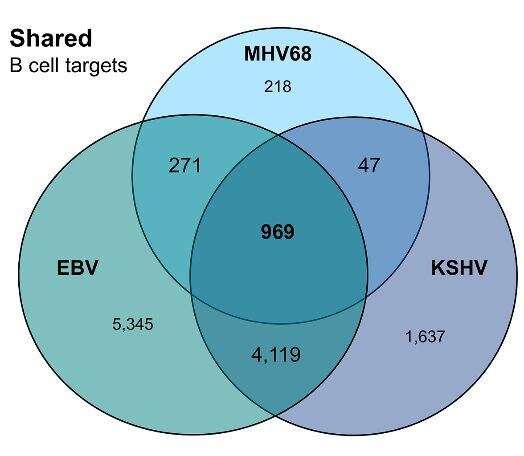Different gammaherpesviruses suppress largely overlapping host cellular pathways

The discovery of thousands of host mRNAs targeted by gammaherpesvirus microRNAs (miRNAs) could shed light on the biology of gammaherpesviruses and how these pathogens establish lifelong infections, according to a study published August 8 in the open-access journal PLOS Pathogens by Scott Tibbetts of the University of Florida, and colleagues.
Gammaherpesviruses, including the human pathogens Epstein-Barr virus (EBV) and Kaposi's sarcoma-associated herpesvirus (KSHV), establish lifelong infections in immune cells called B cells, and are associated with a variety of tumors. Within their genomes, these viruses encode numerous molecules called miRNAs, which target and suppress mRNAs—the products of specific genes—within infected host cells. However, the function of these miRNAs during infection in living organisms is largely unknown. Murine gammaherpesvirus 68 (MHV68) is a natural pathogen of rodents that is genetically related to both EBV and KSHV, and thus serves as an excellent model for the study of EBV and KSHV. But until now, the specific targets of MHV68 miRNAs were completely unknown.
In the new study, Tibbetts and colleagues identified and validated thousands of new MHV68 miRNA targets. Detailed molecular analyses of specific interactions demonstrated that these MHV68 miRNAs repress numerous host mRNA targets. Notably, of the 1,505 MHV68 miRNA-host mRNA targets identified in B cells, 86% were shared with either EBV or KSHV, and 64% were shared among all three viruses, demonstrating significant conservation of gammaherpesvirus miRNA targeting. Further analyses revealed that MHV68 miRNAs target host mRNAs that are involved in protein synthesis and protein modification. These findings provide substantial new information about specific targets of MHV68 miRNAs and shed important light on likely conserved functions of gammaherpesvirus miRNAs.
More information: Whitney L. Bullard et al, Identification of murine gammaherpesvirus 68 miRNA-mRNA hybrids reveals miRNA target conservation among gammaherpesviruses including host translation and protein modification machinery, PLOS Pathogens (2019). DOI: 10.1371/journal.ppat.1007843
















